Simple, quick and very tasty recipes for pickling cabbage for the winter
Pickling cabbage for the winter is the easiest and most reliable way to preserve the harvest. Natural preservatives during storage are salt and lactic acid. They protect the product from spoilage, prevent the development of harmful microorganisms and give the pickling a special taste.
There are a huge number of options for how to pickle cabbage for the winter at home. But to make it tasty and crispy, you need to take into account certain subtleties: choose the right head of cabbage, strictly follow the process technology.
Which cabbage is suitable for making pickles for the winter: selection and preparation
White cabbage varieties are suitable for pickling for the winter. The best fork is considered to be the one that has matured the longest in the garden. It has accumulated more sugar needed for fermentation.
Important. Early varieties are not suitable for pickling. They contain little sugar and the leaves are too tender. During the fermentation process, such cabbage becomes soft and tasteless, and the crispy effect disappears.
Mid-season varieties are also suitable for pickling. They have a harder fork and sufficient sugar content. They are grown in central Russia and in the northern regions, where cabbage has time to ripen in 130 days. The best varieties and hybrids suitable for pickling: Slava 1305, Podarok, Belorusskaya, Menza F1, Dobrovodskaya.
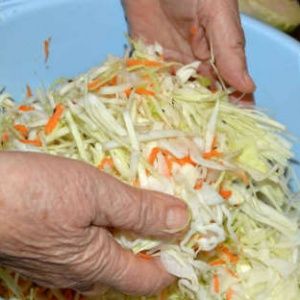
Late-ripening varieties are ideal for pickling. They have dense, crispy bites loaded with lots of sugar. This type of cabbage is grown in the south and central Russia.The growing season is 150-180 days.
The best varieties and hybrids: Moscow late, Kharkov winter, Valentina F1, Snow White, Mara.
For pickling, choose large white heads of cabbage. It is the white leaves that contain the sugar necessary for fermentation. Green heads of cabbage are not suitable for harvesting.
Advice. The fork is checked for tightness by squeezing it with your hands. If you hear a crunch, then this head of cabbage is suitable for pickling. The density of the head of cabbage determines the quality of the final product: the harder it is, the more crunchy the salted cabbage will be.
The head of cabbage is also tasted. Cabbage should not be bitter. If it is juicy and sweet, then the salty one will be tasty.
From the selected heads of cabbage I remove the top 2-3 leaves - they are usually dirty and scratched. The forks are washed with running water and dried with a paper towel. Cut into 2-4 pieces to make shredding convenient. Grind with a knife or a special shredder. The stalk is not used, as harmful substances accumulate in it.
Delicious pickling recipes for the winter
Let's consider recipes pickling cabbage for the winter, according to which it is prepared simply, quickly and tasty.
Pickling cabbage in a quick way
This is an easy, popular way to quickly cook cabbage.
Ingredients: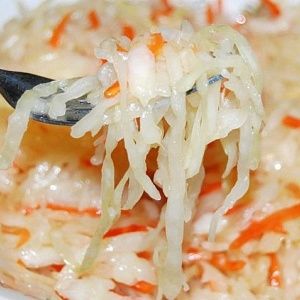
- white cabbage - 2.5 kg;
- carrots - 1 pc.;
- salt - 2 tbsp. l.;
- sugar - 2 tbsp. l.;
- water - 1.5 l.
The head of cabbage is chopped into thin strips, the carrots are grated on a coarse grater, and everything is thoroughly mixed. There is no need to mash this cabbage.
The mixed vegetables are placed in a glass jar, filling to the neck. Salt and sugar are poured on top. Fill with water. To get as much water in as possible, cabbage pierce to the bottom with a wooden skewer. The water should cover it completely.
The jar is covered with a plastic lid and placed in a deep bowl.Leave it like this for 2-3 days at room temperature. To prevent the cabbage from turning out bitter, it is periodically pierced with a wooden skewer, releasing the accumulated gas.
Advice. Make sure that the brine completely covers the cabbage. If there is none on the surface, add fresh brine to the jar.
After 3 days, the finished product is covered with a lid. Store in the refrigerator.
Any spices can be added to the cabbage to taste: bay leaf, dill, coriander, peppercorns, etc.
Spicy Ambassador
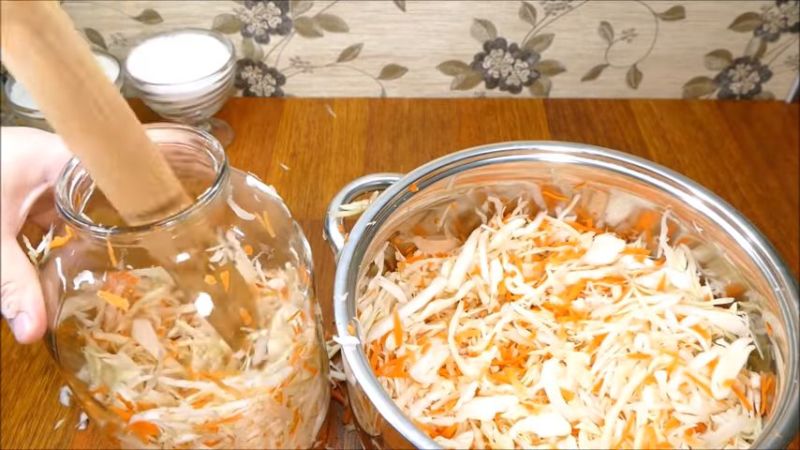
Spices added to cabbage will give it a spicy taste and aroma.
Ingredients:
- white cabbage - 300 g;
- carrots - 200 g;
- onions - 3 pcs.;
- garlic - 2-3 cloves;
- salt - 2 tsp;
- sugar - 0.5 tbsp. l.;
- vinegar 9% - 1.5 tbsp. l.;
- water - 0.5 l;
- peppercorns - 15 pcs.;
- bay leaf - 3 pcs.;
- hot pepper - 1 pod.
The fork is chopped into strips with a knife or shredder, the carrots are grated, the onions are cut into rings. A sterilized jar is filled in layers: part of the cabbage so that it covers the bottom of the jar, then part of the carrot so that it covers the cabbage, then part of the onion so that it covers the carrots. This way the entire jar is filled. The last layer is layered with sliced garlic.
Prepare the brine: pour sugar and salt, peppercorns, bay leaves into a saucepan with water, add a pod of hot pepper. Bring to a boil and boil for 1 minute.
Then vinegar is poured into the jar and hot is poured on top marinade.
Advice. If you like a spicy snack, add hot peppers from the brine to the jar of cabbage.
Close the jar with a lid and leave for 12 hours at room temperature. Then put in the refrigerator. After a day, tasty, crispy cabbage is ready to eat.
With garlic and pepper
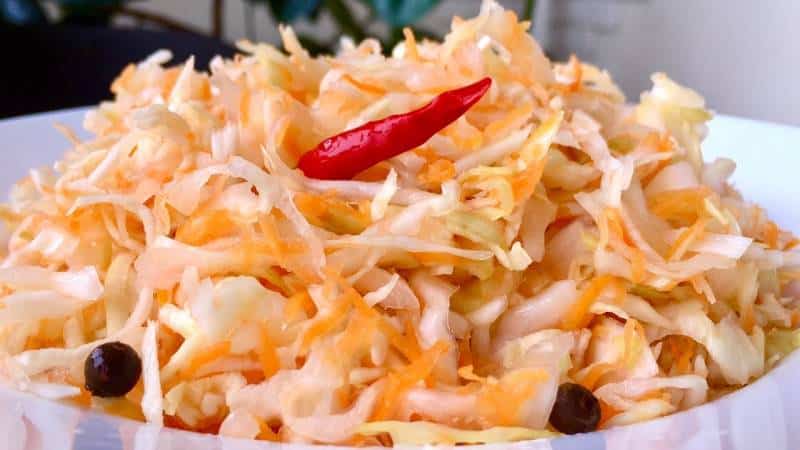
The taste of cabbage in combination with garlic and pepper is rich and spicy.
Ingredients:
- cabbage - 800 g;
- carrots - 3 pcs.;
- sweet red pepper - 2 pcs.;
- garlic - 6 cloves;
- salt - 2 tbsp. l.;
- sugar - 200 g;
- vinegar 9% - 200 ml;
- water - 1 l.
For this amount of products you will need 3 750 ml jars.
Chop the forks, grate the carrots on a coarse grater, cut the pepper into strips, and mix everything thoroughly. Sterilized jars are filled halfway with the resulting mass and 2 cloves of garlic are added on top. Then add the vegetables, pressing them with your fingers.
Prepare the marinade: pour vinegar into a saucepan with water, add sugar and salt, and bring to a boil.
Pour hot marinade over vegetables.
Advice. If desired, you can add vegetable oil to the marinade - 100 ml per 800 g of cabbage.
Cover the jars with sterilized lids and leave until completely cool. Place in the refrigerator for storage. After a day, the product is ready for use.
With dill seeds
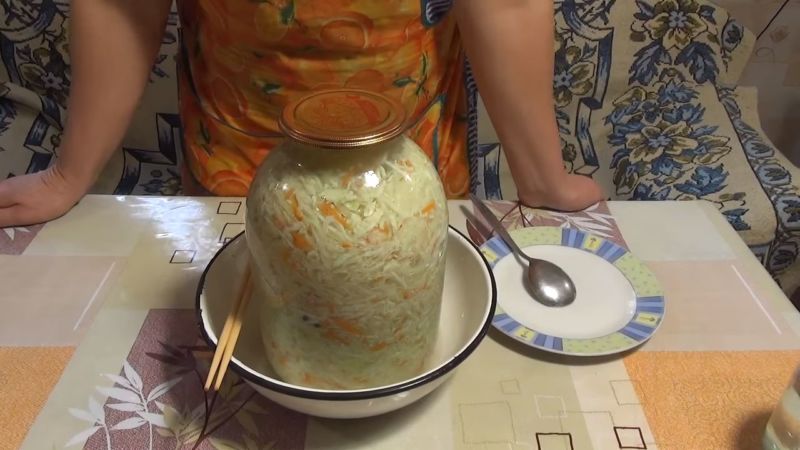
Dill seeds will give cabbage a piquant taste and aroma.
For preparation you will need:
- white cabbage - 2 kg;
- carrots - 2 pcs.;
- dried dill seeds - 120 g;
- red pepper pod - 1 pc.;
- salt - 90 g;
- sugar - 80 g;
- water - 2 l;
- vegetable oil - 150 ml;
- parsley and dill to taste.
Cabbage, herbs and pepper are chopped, carrots are grated on a medium grater. Place the prepared vegetables and herbs in an enamel pan and mix thoroughly.
Prepare the marinade: add salt, sugar and vegetable oil to the water. They put it on fire. Before boiling, add dill seeds to the brine.
Vegetables are poured with boiling brine, pressed under pressure and left for 2 days at room temperature. Then they are put into jars.The finished product is placed in the refrigerator for long-term storage.
With beets
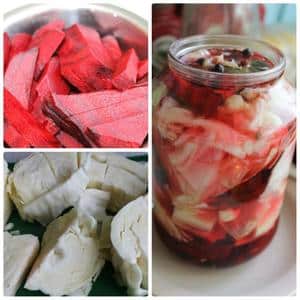
Thanks to the addition of beets, cabbage acquires a pleasant raspberry color and a slight sweetish taste.
Ingredients:
- white cabbage - 3 kg;
- beets - 2 pcs.;
- salt - 2 tbsp. l.;
- sugar - 1 tbsp. l.;
- water - 1.5 l.
The cabbage is chopped into thin strips. The beets are chopped on a coarse grater or a Korean carrot grater. The vegetables are mixed and placed in jars.
Salt and sugar are diluted in warm water and the resulting brine is poured over the workpiece. To ensure that the water fills the jars completely, the vegetables are pierced with a wooden skewer. Cover the jars with lids and place in bowls. Leave at room temperature for 3 days. Vegetables are periodically pierced with a wooden skewer to release air. Then cover with plastic lids and store in the refrigerator.
With cranberries
After adding cranberries The cabbage turns out crispy and juicy. It contains a large amount of vitamin C.
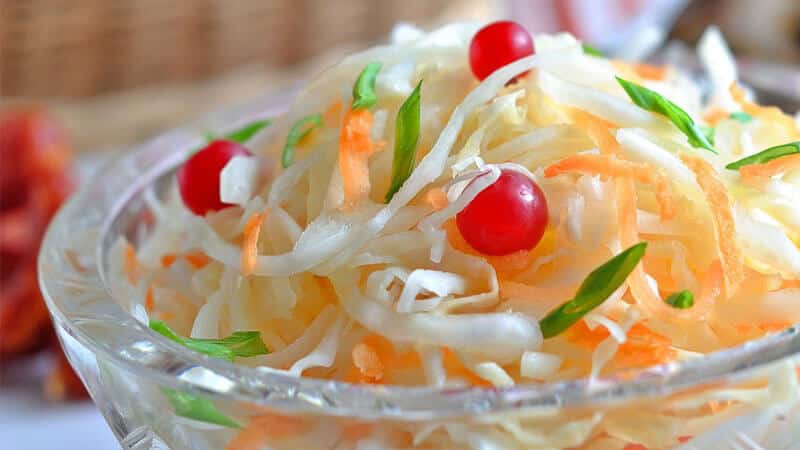
To prepare you will need:
- white cabbage - 5 kg;
- carrots - 5 pcs.;
- cranberries - 200 g;
- bay leaf - 5 pcs.;
- black peppercorns - 15 pcs.;
- salt - 150 g.
The forks are chopped into strips, the carrots are grated. Place the vegetables in an enamel container, mix with cranberries, cover with salt, add pepper and bay leaf. Mix everything thoroughly and cover with a plate. Pressed under pressure.
The juice released from the cabbage should cover it completely. Place the container with the product in a dark place for 3 days, stirring occasionally to release the gas. Then the finished product is placed in jars and stored in the refrigerator or cellar for a long time. storage.
Cabbage "Three days"
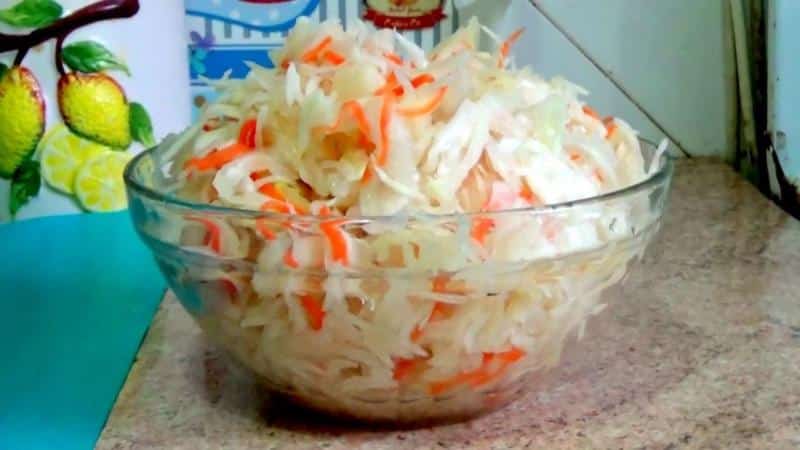
With this method of harvesting, the cabbage retains maximum nutrients.
For a three-liter jar you will need:
- white cabbage - 1 small head;
- carrots - 1 pc.;
- water - 1 l;
- salt - 1 tbsp. l.;
- sugar - 1 tbsp. l.
The head of cabbage is chopped and mixed with grated carrots. Place in a three-liter jar. Prepare the brine: boil water along with salt and sugar. Hot brine is poured over the vegetables. The jar is placed in a deep bowl. Leave for 3 days at room temperature. To remove gas, vegetables are periodically pierced with a wooden stick. After 3 days the product is ready for use. Store it in the refrigerator.
Cold way
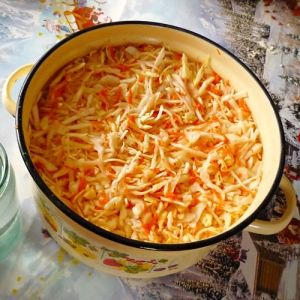
Cold-cooked cabbage retains its natural taste, texture and aroma.
Required ingredients:
- white cabbage - 1 kg;
- carrots - 1 pc.;
- garlic - 3 cloves;
- vegetable oil - 50 ml;
- salt - 100 g;
- sugar - 50 g;
- black peppercorns - 5 pcs.;
- vinegar 9% - 50 ml;
- water - 0.3 l.
The forks are chopped into strips. Grate the carrots on a coarse grater.
Prepare the brine: Mix salt, sugar, vegetable oil and vinegar, add water brought to a boil. The garlic is crushed and added to the brine.
Mix cabbage and carrots in a container, rubbing them with your hands to release the juice. Then pour in chilled brine. The top is covered with a lid on which oppression is placed.
The workpiece is left at room temperature for 2 hours. After 2 hours, it is stirred and left under the lid for 7 hours.
The finished product is transferred to jars and stored in the refrigerator.
Hot method
One of the fastest ways to obtain the finished product.
For preparation you will need: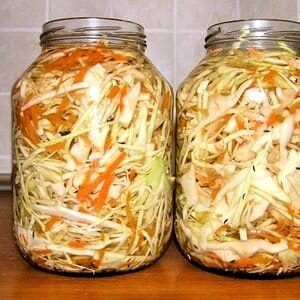
- white cabbage - 300 g;
- carrots - 100 g;
- bell pepper - 100 g;
- sea salt - 1 tbsp. l.;
- sugar - 2 tbsp. l.;
- water - 1 l.
The head of cabbage is chopped, the carrots are grated, the pepper is cut into strips.The vegetables are mixed and placed in sterilized jars.
Prepare the brine: boil water with salt and sugar for 3 minutes. Hot brine is poured over the vegetables.
After a day, the product is completely ready for use. Store it in the refrigerator.
Advice from experienced housewives
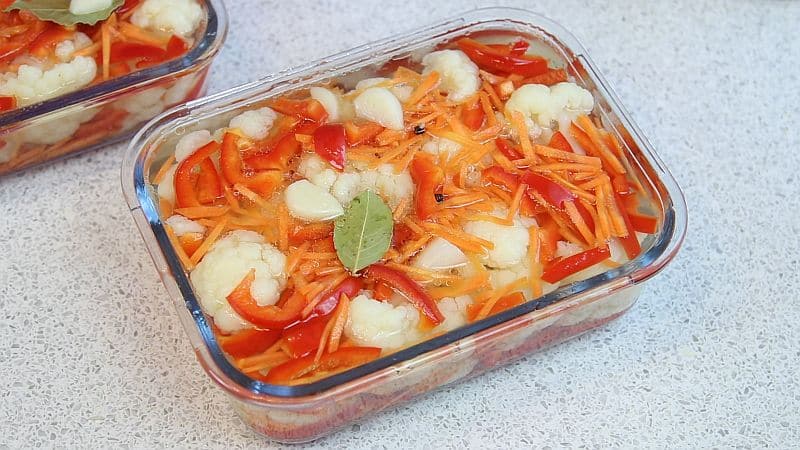
Experienced housewives for pickling advise:
- choose round-shaped heads of cabbage with flattened ends - they contain more sugar;
- use coarse salt without additives;
- To prevent the cabbage from becoming bitter, pierce it or stir with a wooden spoon;
- do not add a lot of carrots, as they can soften the cabbage - one small carrot is enough for a small head of cabbage (2 kg);
- use wooden barrels, tubs or enamel dishes, but not metal-coated dishes.
According to the lunar calendar, cabbage will turn out tasty and crispy if you pickle it 5-6 days after the new moon. And the waning and full moon can lead to rapid softening and oxidation of the product.
The optimal storage temperature for salted cabbage is 0…+4°C. Therefore, it is recommended to store it in a cellar or refrigerator. Do not store workpieces near a radiator or other heat sources.
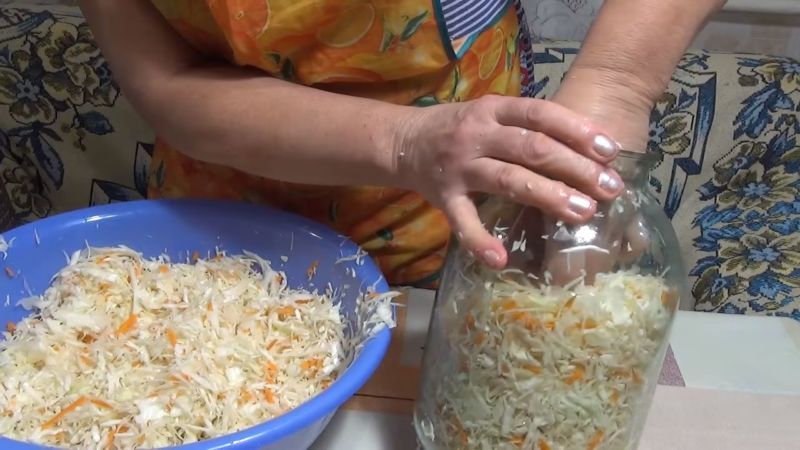
Conclusion
Salted cabbage is tasty and healthy. It is served plain or seasoned with oil and herbs, added to soups, salads and pies.
To ensure that the finished product is tasty and crispy, white cabbage of mid-season or late varieties is chosen for pickling for the winter. To give it a piquant taste, add other vegetables (carrots, peppers, beets), berries and spices. Store the preparations in the basement, cellar or refrigerator.